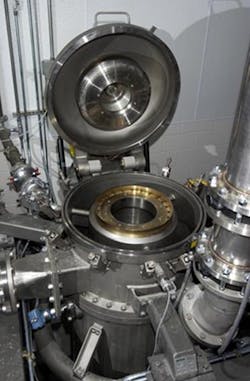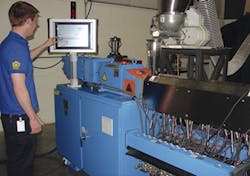Firm combines compounding, extruding with micronizing services
Custom Processing Services is a toll manufacturer that has carved out a niche service, combining plastics compounding and extruding services with particle size-reduction.
"It is enabling our customers to develop different products that have unique properties and improved overall efficiencies that can be introduced into the marketplace for newer and improved products at equal or lesser sale price," said Jeffrey A. Klinger, Custom Processing Services VP.
As an example, Klinger said medical device manufacturers increasingly are demanding plastic in the form of micronized particles. By micronizing plastic particles used to manufacture the devices, the different types of plastic "bond and gel" together, giving them the increased durability and strength required for the product.
Micronization refers to the reduction of average particle diameters to the micrometer or even nanometer range.
Medical devices in which micronized particle plastics are used include tubes and peripherally inserted central catheters (PICCs), which are a form of intravenous-access catheters that can be used for a prolonged period. A range of plastic materials, including PEEK, PC and polysulfones, are used in devices made by the company's customers.
"These are some of the types of devices being generated where these micronized plastics have to be used," Klinger said.
Not many companies are involved in micronizing and ultra-fine grinding of materials — including plastics, minerals and waxes — on a contract basis, and Klinger said his company is the only one he knows of that combines the service with plastics compounding and extruding.
"I don't know of anyone else who does it the same way we do," he said.
Klinger and Gregg Shemanski founded Custom Processing Services in 1998, and the company started production in January 2000. The company uses the latest technology to micronize particles their customers use in manufacturing plastic parts, cosmetics, personal care items, adhesives, industrial paints and finishes, inks, coatings and other products.
The company has about 150 employees and operates 24 hours per day, seven days a week.
"We produce more micronized plastics on a contract basis than anybody else in the world," Klinger said. "We produce an awful lot of micronized plastic and waxes. This is a very important aspect of what we are doing right now — coming up with different products through the extruding and micronizing processes."
Depending on product mix, the company produces about 8,000 to 10,000 tons of micronized plastics and waxes annually, he said.
"We have a lot of engineers on staff. We have process engineers, chemical engineers, where we utilize all of that experience and education to come up with unique ways to process these materials to meet or exceed our customers' expectations. We're very specialized. We have a good R&D group, and we have them develop new products and new technologies with our customers."
The company is limited in what it can reveal about its customers and their products, and in some cases, it might not know the end product made from its materials.
In its work with polymers and plastics in particle-size reduction, the company starts by either accepting pre-compounded materials from a client or working with the client to compound the materials.
For compounding, it uses a Coperion ZSK92 high-performance, twin-screw, co-rotating extruder, which it added in 2011. The extruder enables ingredients to be added to the mixture at the correct times.
"We have nine different heat zones, and how you introduce the raw materials to the compounding equipment has a lot to do with its ability to be micronized to specific sizes efficiently," Klinger said. Coperion has "newer technology that provides a 30 percent increase in torque as compared to previous models. It makes it a much more efficient system. It is a very energy-efficient operation. It gives you a wide range of applications."
While some companies take all the ingredients, including plastics and fillers, and put them into one kettle to melt into a chunk of plastic for micronizing, Custom
Processing Services takes advantage of the extruder's nine heat zones, which allow temperature-sensitive materials to be introduced at the appropriate time so that they are blended well without being exposed to excessive temperatures.
"What we have learned is that … how you introduce the raw materials to the compounding equipment has a lot to do with [their] ability to be micronized to specific sizes efficiently," Klinger said.
The company also has a variety of related equipment, including a fluid bed dryer from Witte, a flash dryer from Fluid Energy, in-line screw conveyors from Flexicon and volumetric feeders from Coperion K-Tron. It also has numerous double-ribbon blenders with capacities from 100 to 7,500 liters custom-made to the company's detailed specifications.
In certain situations, by compounding plastics on-site, Custom Processing Services "has been able to improve upon our micronizing rate by 10 to 20 percent," he said. "That makes for a more efficient, more effective and more marketable process."
With its technologies, the company can produce materials that enable its customers to bring innovative products to market.
"We process a variety of polymers, resins and other customized plastics requiring cryogenic grinding with nitrogen," Klinger said. "We do not extrude parts at this time, but with customized die heads we process some specialized extruded shapes for various applications."
After the compounded material is extruded, Custom Processing Services can use one of several methods for reducing particle size, Klinger said.
One method is sending the material through a fluidized-bed jet mill, where compressed air is blasted at supersonic velocities to force particles to collide.
The mill is manufactured by Netzsch Group, headquartered in Selb, Germany.
"It is like taking two rocks and throwing them against each other and breaking them down," Klinger said. "It is particle-on-particle collision."
Another option for particle size reduction is wet grinding or media milling, in which the compounded product, after extrusion, is chopped into a form that can be introduced into a Netzsch Small Media Mill, an enclosed vessel filled with a liquid and thousands of small spheres or beads that act as the grinding media.
They are activated by a high-speed agitator shaft, creating shearing and impacting forces. The forces either tear apart or crush the solids, resulting in an overall reduction in particle size. At the same time, the particles are dispersed in the liquid. Grinding media is retained inside the mill by the Netzsch patented dynamic cartridge media separator.
Bruce Geiselman, senior staff reporter
Contact:
Custom Processing Services,Reading, Pa., 610-779-7001, www.customprocessingservices.com
About the Author
Bruce Geiselman
Senior Staff Reporter Bruce Geiselman covers extrusion, blow molding, additive manufacturing, automation and end markets including automotive and packaging. He also writes features, including In Other Words and Problem Solved, for Plastics Machinery & Manufacturing, Plastics Recycling and The Journal of Blow Molding. He has extensive experience in daily and magazine journalism.



